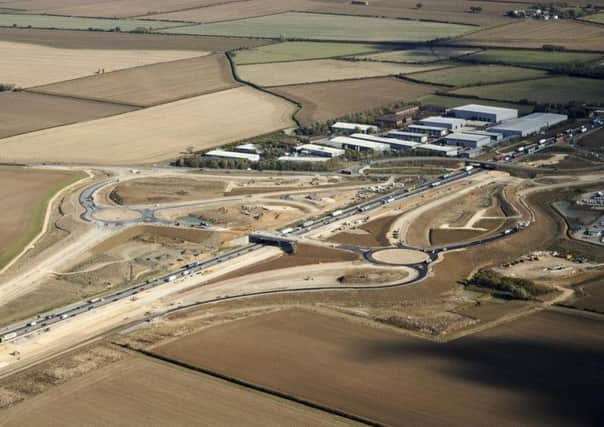Drivers warned of weekend A14 closure as bridge is removed


The £1.5bn upgrade of the A14 in Cambridgeshire is due to hit another milestone next weekend, when Highways England plans to demolish a bridge at Swavesey.
The Swavesey junction, junction 28 of the A14, is being extensively modernised as part of the project to upgrade 21 miles of the A14 between Cambridge and Huntingdon, and the bridge is being removed following the opening of a new bridge across the widened A14 on Saturday 3 November.
Advertisement
Hide AdAdvertisement
Hide AdIt will be taken down in a carefully planned weekend operation between 2am on Saturday, November 17 and 6am on Monday, November 19.
Julian Lamb, construction director for the A14 Cambridge to Huntingdon scheme on behalf of Highways England, said:
“Redesigning Swavesey junction is a key part of upgrading the A14 and the new junction will serve communities like Swavesey, Boxworth and surrounding villages, while enabling drivers to join and leave the new A14 safely and smoothly and accessing Cambridge Services. The new junction, which currently provides access to and from the old A14 will ultimately allow road users to access both the new A14 and the local access road.
“With the new junction bridge now open for traffic, it is time to remove the old one. The only way to complete the work safely is to close the A14 beneath it, and by completing the work over a single weekend, we hope to keep disruption to an absolute minimum.”
Advertisement
Hide AdAdvertisement
Hide AdThe existing bridge which links Swavesey to Boxworth at junction 28 of the A14 is nearly 40 metres long and 13 metres wide, and is supported by steel nine beams and two concrete abutments.
It will be taken down by six excavators, each up to 100 foot long, which will crunch up the concrete deck before moving onto the central pier and finally the two abutments. The material from the bridge will then be moved overnight using 30 dumper trucks, before being recycled and re-used as part of the construction of the new A14.
The new 2,127 tonne bridge, spanning almost 60 metres and nearly 20 metres wide, will form part of the new Swavesey junction when the upgraded road opens by the end of December 2020. It will be complemented by a new pedestrian and cycle bridge in place of the old bridge and, when the scheme is completed, the old A14 at this location will become a new local access road between Huntingdon and Cambridge, running alongside the new A14.
While the demolition is taking place the A14 will be closed in both directions between junctions 27 (Fenstanton) and 29 (Bar Hill). Drivers will be diverted to take the A1198 and then the A428 when heading eastbound during this time, and follow this route in reverse when heading westbound. Access to Lolworth village, and the hotels and restaurants within the closure that are only accessible via the main carriageway, is being retained for residents and customers via an escort.
Advertisement
Hide AdAdvertisement
Hide AdHighways England is upgrading a 21-mile stretch of the A14 between Cambridge and Huntingdon to three lanes in each direction including a brand new 17-mile bypass south of Huntingdon, with four lanes in each direction between Bar Hill and Girton. The project, which includes 34 main bridges and structures, will add additional capacity, boost the local and national economy and cut up to 20 minutes off journeys.
his latest bridge demolition follows on from Highways England completing work to install two 1,000 tonne bridges over the A14 at Bar Hill 18 hours ahead of schedule a month ago. The work saw a weekend A14 closure while the two 44-metre long bridge decks were wheeled into place and dropped onto abutments that had been built beside the road.